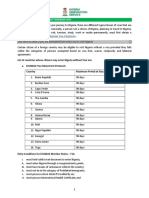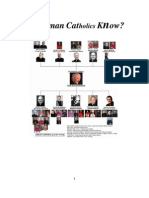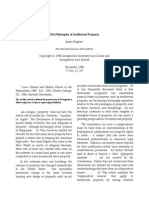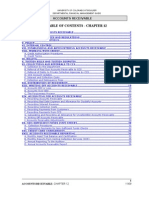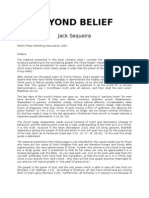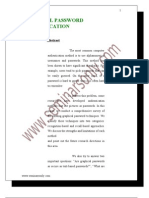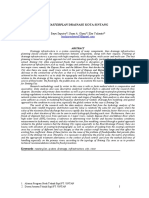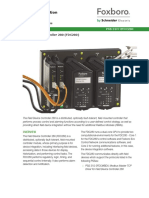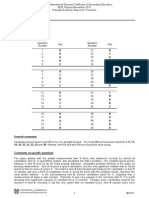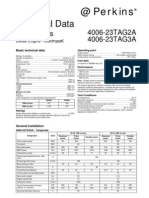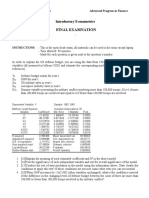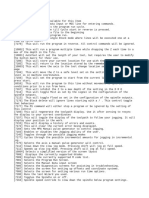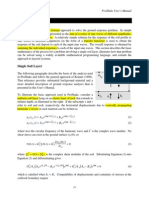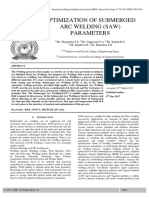1
Abstract
The most common computer authentication method is to use
alphanumerical usernames and passwords. This method has been shown to have
significant drawbacks. For example, users tend to pick passwords that can be
easily guessed. On the other hand, if a password is hard to guess, then it is often
hard to remember.
To address this problem, some researchers have developed
authentication methods that use pictures as passwords. In this paper, we conduct
a comprehensive survey of the existing graphical password techniques. We
classify these techniques into two categories: recognition-based and recall-based
approaches. We discuss the strengths and limitations of each method
and point out the future research directions in this area.
We also try to answer two important questions: Are graphical
passwords as secure as text-based passwords?; What are the major design and
implementation issues for graphical passwords. In this paper , we are conducting
a comprehensive survey of existing graphical image password authentication
techniques.Also we are here proposing a new technique for graphical
authentication.
�2
Pictures are generally easier to be
remembered or recognized than text. In
addition, if the number of possible
Introduction:
pictures is sufficiently large, the possible
Human factors are often considered the
password space of a graphical
weakest link in a computer security
password scheme may exceed that of
system. pointout that there are three
text-based schemes and thus presumably
major areas where human-computer
offer better resistance to dictionary
interaction is important: authentication,
attacks. Because of these advantages,
security
there is a growing interest in
operations,
and
developing
secure systems. Here we focus on the
graphical password. In addition to
authentication problem.On the other
workstation and web log-in applications,
hand, passwords that are hard to guess or
graphical passwords have also been
break are often hard to remember.
applied to ATM machines and mobile
Studies showed that since user can only
devices.
remember
In
limited
number
of
this
paper,
we
conduct
passwords, they tend to write them down
comprehensive survey ofthe existing
or will use the same passwords for
graphical password techniques. We will
different
the
discuss the strengths and limitations of
problems with traditional username-
each method and also point out future
password
alternative
research directions in this area. In this
such
paper, we want to answer the following
accounts.
To address
authentication,
authentication
methods,
as
biometrics, have been used. In this
paper, however, we will focus on another
questions:
Are graphical passwords as secure
alternative: using pictures as passwords.
as text passwords?
Graphical password schemes have been
What are the major design and
implementation issues for graphical
passwords?
proposed as a possible alternative to
text-based schemes, motivated partially
by the fact that humans can remember
pictures better than text; psychological
studies
supports
such
assumption.
Overview of the Authentication
Methods:
Current authentication methods can be
divided into
�3
Three main areas:
Token based
authentication
Biometric based
authentication
Knowledge based
authentication
based and recall-based graphical
techniques. Using recognition-based
techniques, a user is presented with a set
of images and the user passes the
authentication by recognizing and
identifying the images he or she selected
during the registration stage. Using
Token based techniques, such as key
recall-based techniques, a user is asked
cards, bank cards and smart cards are
to reproduce something that he or she
widely used. Many token-based
created or selected earlier during the
authentication systems also use
registration stage.
knowledge based techniques to enhance
Recognition Based Techniques
security. For example, ATM cards are
generally used together with a PIN
number.
Biometric based authentication
techniques, such as fingerprints, iris
scan, or facial recognition, are not yet
widely adopted. The major drawback of
this approach is that such systems can be
expensive, and the identification process
can be slow and often unreliable.
However, this type of technique provides
he highest level of security.
Knowledge based techniques are
the most widely used authentication
techniques and include both text-based
and picture-based passwords. The
picture-based techniques can be further
divided into two categories: recognition-
Dhamija and Perrig proposed a
graphical authentication scheme based
on the HashVisualization technique . In
their system, the user is asked to select a
certain number of images from a set of
random pictures generated by a
program . Later, the user will be required
to identify the pre selected images in
order to be authenticated. The results
showed that 90% of all participants
succeeded in the authentication using
this technique, while only 70%
succeeded using text-based passwords
and PINS. The average log-in time,
however, is longer than the traditional
approach. A weakness of this system is
that the server needs to store the seeds of
the portfolio images of each user in plain
�4
text. Also, the process of selecting a set
user moves a frame (and the objects
of pictures from the picture database can
within it) until the pass object on the
be tedious and time consuming for the
frame lines up with the other two pass-
user.
objects. The authors also suggest
repeating the process a few more times
to minimize the likelihood of logging in
by randomly clicking or rotating. The
main drawback of these algorithms is
that the log in process can be slow.
Random images used by Dhamija and
Perrig
Sobrado and Birget developed a
graphical password technique that deals
with the shoulder-surfing problem. In the
first scheme, the system will display a
A shoulder-surfing resistant
graphical password scheme
number of pass-objects (pre-selected by
user) among many other objects. To be
Man, et al. proposed another shoulder-
authenticated, a user needs to recognize
surfing resistant algorithm. In this
pass-objects and click inside the convex
algorithm, a user selects a number of
hull formed by all the pass-objects.In
pictures as pass-objects. Each pass-
order to make the password hard to
object has several variants and each
guess, Sobrado and Birget suggested
variant is assigned a unique code.
using 1000 objects, which makes the
During authentication, the user is
display very crowded and the objects
challenged with several scenes. Each
almost indistinguishable, but using fewer
scene contains several pass-objects (each
objects may lead to a smaller password
in the form of a randomly chosen
space, since the resulting convex hull
variant) and many decoy-objects. The
can be large. In their second algorithm, a
user has to type in a string with the
�5
unique codes corresponding to the pass-
enrollment stage, a user selects a theme
object variants present in the scene as
(e.g. sea, cat, etc.) which consists of
well as a code indicating the relative
thumbnail p
location of the pass-objects in reference
to a pair of eyes. The argument is that it
is very hard to crack this kind of
password even if the whole
authentication process is recorded on
video because where is no mouse click
to give away
the pass-object information. However,
photos and then registers a
this method still requires users to
sequence of images as a password
memorize the alphanumeric code for
.During the authentication, the user
each pass-object variant. Hong, et al.
must enter the registered images in the
later extended this approach to allow the
correct sequence. One drawback of
user to assign their own codes to pass-
this technique is that since the number
object variants. However, this method
of thumb nail images is limited to 30,
still forces the user to memorize many
the password space is small. Each
text strings and therefore suffer from the
thumbnail image is assigned a
many drawbacks of text-based
numerical value, and the sequence of
passwords.
selection will generate a numerical
password. The result showed that the
image sequence length was generally
shorter than the textural password
length. To address this problem, two
pictures can be combined to compose a
new alphabet element, thus expanding
An example of Passfaces
the image alphabet size.
Jansen et al proposed a graphical
password mechanism for mobile
device .during the
RECALL BASED
Reproduce a drawing:
Draw-a-Secret (DAS) technique proposed
by Jermyn, et al
Nali and Thorpe conducted further
A graphical password scheme
proposed by Jansen, et al
analysis of the Draw-A-Secret (DAS)
scheme. In their study, users were asked
Jermyn, et al. proposed a technique,
to draw a DAS password on paper in
called Draw - a - secret (DAS), which
order to determine if there are
allows the
predictable characteristics in the
user to draw their unique password .A
graphical passwords that people choose.
user is asked to draw a simple picture on
The study did not find any predictability
a 2D
in the start and end points for DAS
grid. The coordinates of the grids
password strokes, but found that certain
occupied by the picture are stored in the
symmetries (e.g. crosses and rectangles),
order of the drawing. During
letters, and numbers were common. The
authentication, the user is asked to re-
PassPoint system by Wiedenbeck, et
draw the picture. If the drawing touches
al. extended Blonders idea by
the same grids in the same sequence,
eliminating the predefined boundaries
then the user is authenticated. Jermyn, et
and allowing arbitrary images to be
al.
used. As a result, a user can click on any
suggested that given reasonable-length
place on an image (as opposed to some
passwords in a 5 X 5 grid, the full
pre-defined areas) to create a password.
password space of DAS is larger than
A tolerance around each chosen pixel is
that of the full text password space.
calculated. In order to be authenticated,
the user must click within the tolerance
of their chosen pixels and also in the
�7
correct sequence . This technique is
pictures which act as passwords,these
based on the discretization method
are given by server. Since any image is
proposed by Birget, et al. . Because any
made of pixels we have its gray level
picture can be used and because a
concentration. In this way the image will
picture may contain hundreds to
be distorted and cant be in original
thousands of memorable points, the
possible password space is
form.so it is not easy for hacker to
reproduce the original form of image.
The flow chart of the proposed technique
quite large.
is given below.
Step 1:User
will select an
image from
data base as
password
An image used in the Passpoint Sytem,
Step 2:Image
clustering
will takes
place
Step 8 User will
allow sufing on
website
If
passwor
d
mathces
Wiedenbeck, et al
New Technique For Graphical
Password Authentication
. Here we are poposing a new algorithm
of
authentication
using
graphical
Step
3:Distributes the
clusters
throughout
image space
Step 7: image gets
compared to
original
images.when a ;user tries to register over
a network we will ask him or her to selet
a theme or sequence of pictures from
already given image frame.The local
Step 4:password
stores as encrypted
password
host downloads an image frame which
contains various themes of sequence of
Step 5:For login user
wll again asked to
pick up an image
from database
Step 6 Server
reproduce
encrypted image
using neural
networks
Other
wise go
to step
5
�Block diagram for the New
Technique
The
Is a graphical password as
secure as text-based password?
motion to imitate human input, which is
Very little research has been done to
graphical passwords. Overall, we believe
study the difficulty of cracking graphical
a graphical password is less vulnerable
passwords. Because graphical passwords
to brute force attacks than a text-based
are not widely used in practice, there is
password.
no report on real cases of breaking
attack
programs
need
to
automatically generate accurate mouse
particularly difficult for recall based
Dictionary attacks
graphical passwords. Here we briefly
Since recognition based graphical
exam some of the possible techniques
passwords involve mouse input instead
for breaking graphical passwords and try
of keyboard input, it will be impractical
to do a comparison with text-based
to carry out dictionary attacks against
passwords.
this type of graphical passwords. For
Brute force search
some recall basedgraphical passwords it
The main defense against brute force
is possible to use a
search is to have a sufficiently large
dictionary attack but an automated
password space. Text-based passwords
dictionary attack will be much more
have a password space of 94^N, where
complex than a text based dictionary
N is the length of the password, 94 is the
attack. More research is needed in this
number of Printable characters excluding
area. Overall, we believe graphical
SPACE.
passwords are less vulnerable to
Some
graphical
password
techniques have been shown to provide a
dictionary attacks than text-based
password space similar to or larger than
passwords.
that
of
text-based
passwords.
Recognition based graphical passwords
tend to have smaller password spaces
than the recall based methods.
It is more difficult to carry out a brute
force attack against
graphical
passwords than text-based passwords.
Guessing
Unfortunately, it seems that graphical
passwords are often predictable, a
serious problem typically associated
with text-based passwords. For example,
studies on the Passface technique have
shown that people often choose weak
�and predictable graphical passwords.
involving only a small number of users.
Nali and Thorpes study revealed
We still do not have convincing evidence
similar predictability among the
demonstrating that graphical passwords
graphical passwords created with the
are easier to remember than text based
DAS technique . More research efforts
passwords.
are needed to understand the nature of
graphical passwords created by real
A major complaint among the users of
world users.
graphical passwords is that the password
Shoulder surfing
Like text based passwords, most of
registration and log-in process take too
long, especially in recognition-based
the graphical passwords are vulnerable
approaches. For example, during the
to shoulder surfing. At this point, only a
registration stage,a user has to pick
few recognition-based techniques are
images from a large set of selections.
designed to resist shoulder-surfing .
During authentication stage, a user has
None of the recall-based based
to scan many images to identify a few
techniques are considered
pass-images.
should-surfing resistant.
Users may find this process long and
tedious. Because of this and also because
What are the major design and
implementation issues of
graphical passwords?
Security
In the above section, we have briefly
examined thesecurity issues with
graphical passwords.
Usability
most users are not familiar with the
graphical passwords, they often find
graphical passwords less convenient than
text based passwords.
Reliability
The major design issue for recall-based
methods is the reliability and accuracy of
One of the main arguments for graphical
user input recognition. In this type of
passwords is that pictures are easier to
method, the error tolerances have to be
remember than text strings. Preliminary
set
user studies presented in some research
carefully overly high tolerances may
papers seem to support this. However,
lead to many false positives while overly
current user studies are still very limited,
low tolerances may lead to many false
negatives. In addition, the more error
�tolerant the program, the more
to
vulnerable it is to attacks.
preliminary analysis suggests that it is
Storage and communication
more
Graphical passwords require much more
storage spacethan text based passwords.
support
difficult
this
to
argument.
break
Our
graphical
passwords using the traditional attack
methods such as brute force search,
Tens of thousands of pictures may have
dictionary attack,or spyware. However,
to be maintained in a centralized
since there is not yet wide deployment of
database. Network transfer delay is also
graphical
a concern for graphical passwords,
password
systems,
the
vulnerabilities of graphical passwords
especially for recognition-based
are still not fully understood.
techniques in which a large number of
Overall, the current graphical password
pictures may need to be displayed for
techniques are still immature. Much
each round of verification.
more research and user studies are
Conclusion:
needed
The past decade has seen a
for
graphical
password
techniques to achieve higher levels of
growing interest in using graphical
maturity and usefulness.
passwords as an alternative to the
References:
traditional text-based passwords. In this
paper,
we
have
comprehensive
conducted
survey
of
existing
graphical password techniques. The
current graphicalpassword techniques
can be classified into two categories:
recognition-based
and
recall-based
techniques..
Although
the
main
argument
for
graphical passwords is that people are
better
at
memorizing
graphical
passwords than text-based passwords,
the existing user studies are very limited
and there is not yet convincing evidence
[1] A. S. Patrick, A. C. Long, and S.
Flinn, "HCI and
Security Systems," presented at CHI,
Extended
Abstracts (Workshops). Ft. Lauderdale,
Florida, USA.,
2003.
[2] A. Adams and M. A. Sasse, "Users
are not the enemy:
why users compromise computer
security mechanisms
and how to take remedial measures,"
Communications
of the ACM, vol. 42, pp. 41-46, 1999.
[3] K. Gilhooly, "Biometrics: Getting
Back to Business," in
Computerworld, May 09, 2000.





